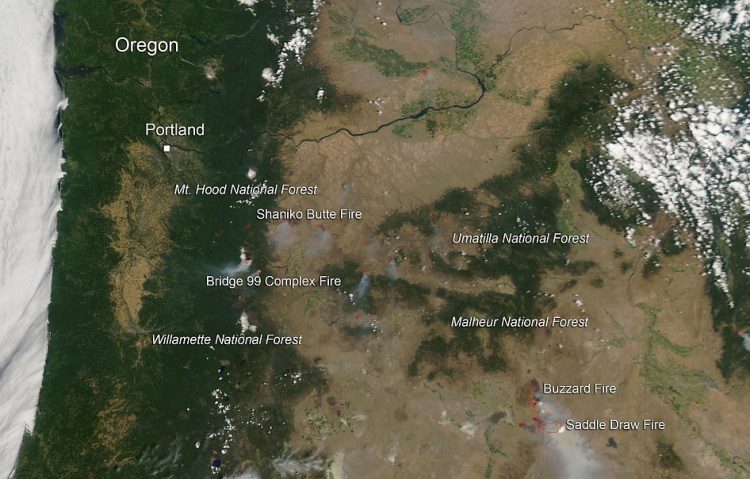Dozens of Fires Plague Oregon

Thousands of lightning strikes Sunday (7/13) and early Monday (7/14) probably started most of the wildfires, which are burning on private, public and reservation land. Dozens of fires are plaguing the forest areas in the state of Oregon.
In this image, are shown the Buzzard Fire, the Shaniko Butte fire, the Bridge 99 Complex fire, and the Saddle Draw Fire.
The Buzzard Complex fire began as a lightning strike. Difficult terrain, combined with extremely dry fuels and hot and windy conditions are giving firefighters a steady challenge. Livestock, private property, several ranches, outbuildings, sage grouse habitat and agriculture lands are threatened.
At last report, one barn was lost on July 14. Heavy air tankers, single engine air tankers, helicopters, fire engines, handcrews, dozers and other equipment are on scene and will work around the clock to protect residences and limit fire spread as much as possible.
The fire is currently at 90,000 acres. The complex is made up of several different fires that span intermittently from their origins near the Lamb Ranch/Warm Springs Reservoir area south to the Beaver Table/Twin Reservoir area near Venator.
The Shaniko Butte fire began as a lightning strike on July 15, 2014. It is located fifteen miles north of Warm Springs, OR. Fueling the fire is juniper, brush, and grass. The fire has been exhibiting extreme fire behavior. Evacuations are in effect. Structures are threatened. There are 10,000 acres currently burning within this fire complex.
The Bridge 99 Complex Fire Eighteen began on July 15, 2014 with a lightning strike. The fire is eighteen miles north of Sisters, OR. Fueling the fire is mixed conifer, brush and grass.
There is active fire behavior and road closures are in effect. The fire is less than 24 hours old at this point and 300 acres have burned so far.
The Saddle Draw fire is 19 miles south of Crane, OR. Extreme fire behavior is ongoing. Residences are threatened with this fire. This is mostly a grass fed fire. Inciweb did not specify what started this particular fire.
This natural-color satellite image was collected by the Moderate Resolution Imaging Spectroradiometer (MODIS) aboard the Aqua satellite on July 15, 2014. Actively burning areas, detected by MODIS’s thermal bands, are outlined in red. NASA image courtesy Jeff Schmaltz, MODIS Rapid Response Team. Caption: NASA/Goddard, Lynn Jenner with information from Inciweb.org and http://www.nifc.gov/nicc/sitreprt.pdf
Media Contact
More Information:
http://www.nasa.gov/content/goddard/dozens-of-fires-plague-oregon/All latest news from the category: Earth Sciences
Earth Sciences (also referred to as Geosciences), which deals with basic issues surrounding our planet, plays a vital role in the area of energy and raw materials supply.
Earth Sciences comprises subjects such as geology, geography, geological informatics, paleontology, mineralogy, petrography, crystallography, geophysics, geodesy, glaciology, cartography, photogrammetry, meteorology and seismology, early-warning systems, earthquake research and polar research.
Newest articles

“Nanostitches” enable lighter and tougher composite materials
In research that may lead to next-generation airplanes and spacecraft, MIT engineers used carbon nanotubes to prevent cracking in multilayered composites. To save on fuel and reduce aircraft emissions, engineers…

Trash to treasure
Researchers turn metal waste into catalyst for hydrogen. Scientists have found a way to transform metal waste into a highly efficient catalyst to make hydrogen from water, a discovery that…

Real-time detection of infectious disease viruses
… by searching for molecular fingerprinting. A research team consisting of Professor Kyoung-Duck Park and Taeyoung Moon and Huitae Joo, PhD candidates, from the Department of Physics at Pohang University…




















